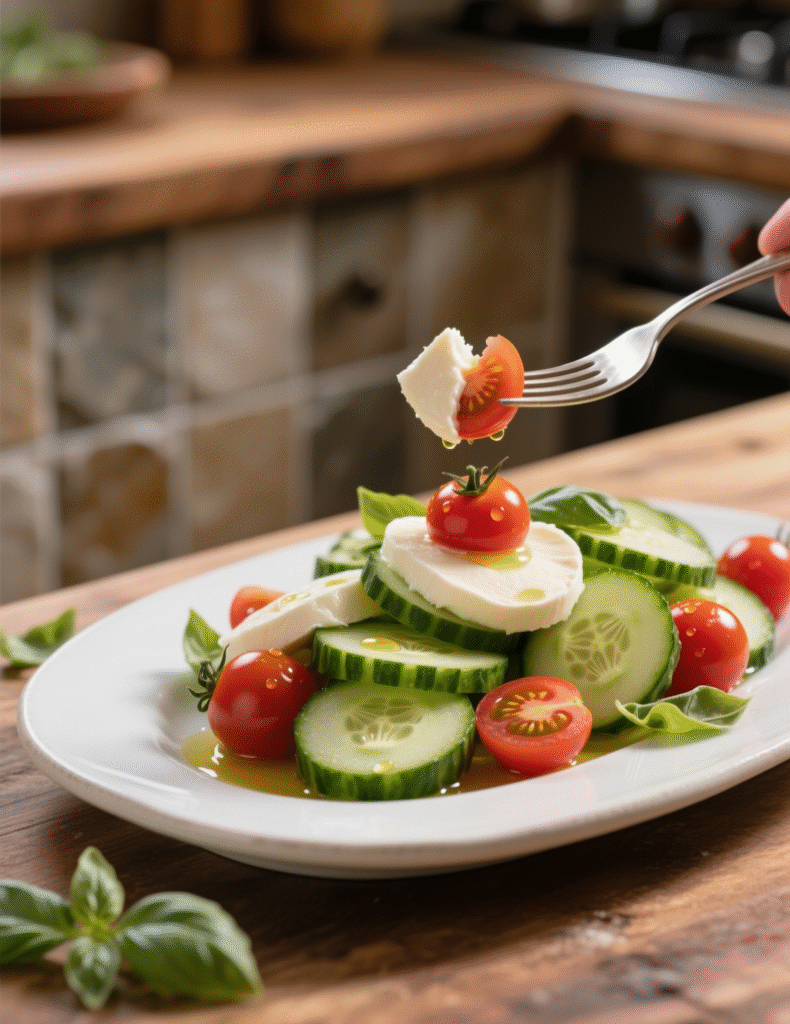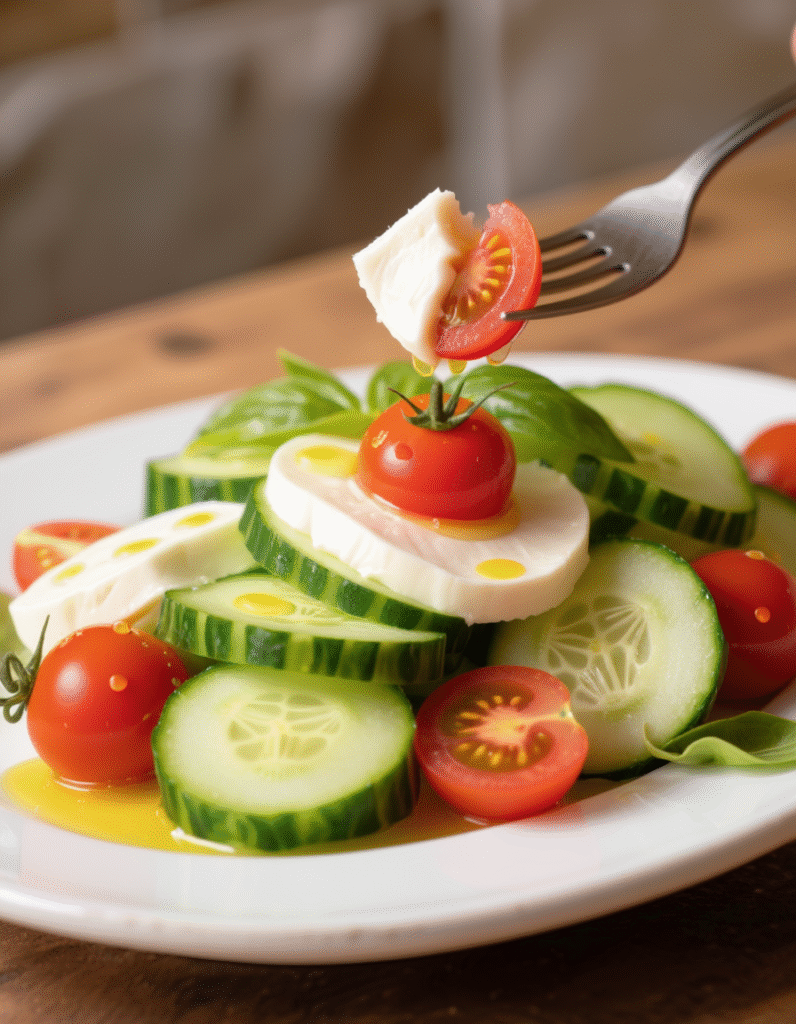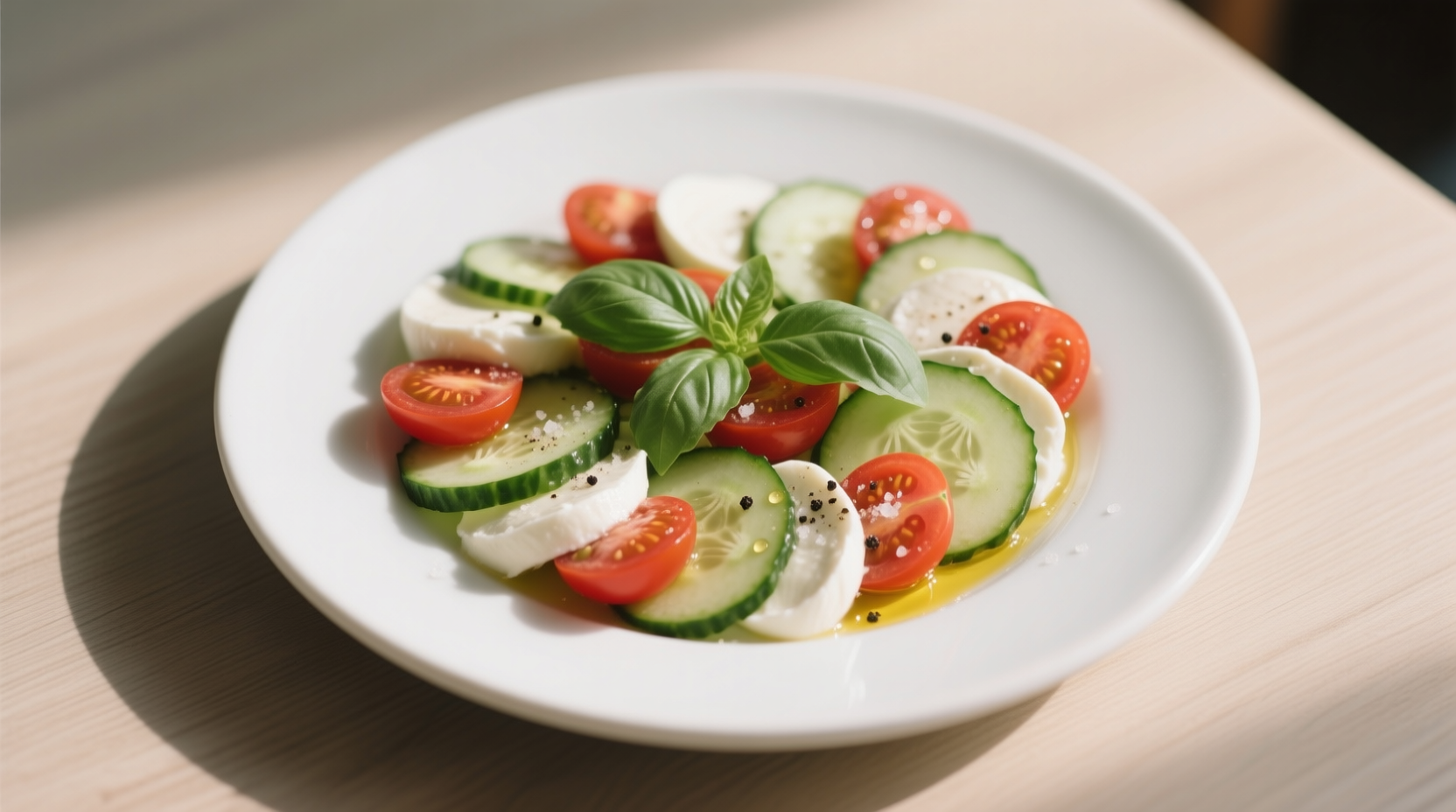Sometimes the simplest dishes get overlooked, but they carry the deepest wisdom. A Caprese salad is one of those—just tomato, mozzarella, basil, olive oil, salt. Nothing fancy, yet it sings. When cucumbers join the ensemble, though, the melody changes in a way that surprises even seasoned chefs. This article dives into the Cucumber Caprese Salad recipe with the lens of a culinary professional, dissecting flavors, textures, nutrition, and even the culinary science that makes it work so well.
Why Reinvent Caprese?
Caprese is a dish born of restraint. Originating from Capri, Italy, it’s a celebration of three peak-season ingredients layered to mimic the Italian flag. Purists insist on tomato, mozzarella, basil, nothing else. Yet food evolves because people dare to add something new.
Cucumbers bring crispness that tomatoes alone can’t. They cool the tongue, balance acidity, and stretch the dish into something refreshing enough for a scorching summer day. In professional kitchens, cucumber is often underestimated. But once you treat it as more than garnish, you realize it can redefine texture balance.
The Science of Cucumber in Caprese
Cucumbers are almost 96% water. That means they behave differently than tomatoes when salted. Tomatoes release juices that deepen flavor as they macerate. Cucumbers, on the other hand, shed water quickly and can dilute a salad if not managed correctly. Professionals usually salt cucumbers lightly and let them sit for 10–15 minutes. This draws out excess liquid and concentrates flavor.
Mozzarella thrives with this adjustment. A cucumber’s crunch keeps the mozzarella’s creamy chew from feeling heavy. The key here is equilibrium: water-laden cucumbers, juicy tomatoes, oily dressing, and a dairy base. Every bite is structured contrast.
Ingredient Quality Matters More Than Quantity
When cooking something like lasagna, a mediocre tomato might hide behind layers of béchamel and meat sauce. But in a Cucumber Caprese Salad, every ingredient is naked. You cannot hide. Professionals know this.
- Cucumbers: Choose firm, thin-skinned varieties like Persian or English cucumbers. Avoid wax-coated ones unless you’re willing to peel. Seeds matter—less is more here.
- Tomatoes: Vine-ripened or heirloom are best. Cherry tomatoes can add sweetness, but they must be ripe enough to burst with juice.
- Mozzarella: Fresh mozzarella balls (bocconcini or ciliegine) are ideal. Burrata works for a luxurious version, though it turns the salad into a creamy mess if handled poorly.
- Basil: Always fresh, never dried. Hand-torn, not chopped. Cutting bruises the leaves and releases bitter polyphenols.
- Olive Oil: Extra virgin, cold-pressed. A salad this raw deserves nothing less.
Step-by-Step: Professional Cucumber Caprese Salad
This isn’t about dumping ingredients into a bowl. Technique separates a professional preparation from an amateur one.
- Prep cucumbers: Slice thin, around ⅛ inch. Salt lightly, let sit for 10 minutes, then pat dry. This removes excess water and sharpens their crunch.
- Slice tomatoes: If using large heirlooms, cut into thick wedges. If cherry, halve them. Keep uniformity for presentation.
- Prepare mozzarella: Drain and pat dry. Excess liquid can water down your dressing. Tear by hand rather than cutting, to create rustic, irregular edges that soak up oil better.
- Basil handling: Tear leaves right before assembling. Never refrigerate basil—it blackens and loses aroma. Keep it at room temperature.
- Assembly: Layer cucumber, tomato, mozzarella, basil. Alternate for balance and visual symmetry.
- Season: Drizzle with olive oil, sprinkle flaky sea salt, and a crack of fresh black pepper. Optionally, add a touch of balsamic reduction, but sparingly—purists cringe at this.

Flavor Enhancements and Variations
Professional kitchens rarely stop at the basics. Chefs tweak. They experiment.
- Acid balance: Instead of balsamic, consider sherry vinegar for nuttiness or lemon zest for a brighter lift.
- Herb swaps: Basil dominates, but fresh oregano or mint can alter the profile. Mint, in particular, pairs beautifully with cucumber.
- Cheese upgrade: Smoked mozzarella or goat cheese creates deeper dimension. Burrata, when served immediately, melts into the cucumber juices like velvet.
- Texture play: Add toasted pine nuts or pumpkin seeds. The crunch contrasts beautifully against the soft mozzarella.
- Plating styles: Stack vertically for a composed, Michelin-style look, or scatter loosely on a platter for rustic charm.
Nutrition and Modern Dietary Trends
Cucumber Caprese Salad isn’t just tasty—it aligns with modern wellness trends. High in hydration, low in calories, and rich in antioxidants, it checks many boxes.
- Calories: Roughly 200–250 per serving (depending on oil and cheese portion).
- Protein: Around 10g from mozzarella.
- Vitamins: Lycopene from tomatoes, vitamin K from cucumber skin, vitamin A from basil.
- Dietary fit: Gluten-free, vegetarian, keto-friendly if tomatoes are minimized.
In professional settings, chefs know diners care about labels—“clean,” “low-carb,” “Mediterranean diet.” This salad fits all of them without compromise.
Common Mistakes Chefs Make
Even experienced cooks stumble here.
- Over-salting cucumbers. A little salt extracts water, too much ruins flavor.
- Using fridge-cold mozzarella. Cold cheese is rubbery. Always let mozzarella come to room temperature before serving.
- Drowning with balsamic glaze. Instagram made this trendy, but in professional kitchens it’s often frowned upon. The glaze dominates, not complements.
- Overcutting basil. Sharp knives bruise, hand-tearing preserves oils.
- Forgetting texture contrast. Thinly slicing everything uniformly makes the dish one-dimensional. Vary thickness slightly for intrigue.
How Professionals Serve It
Presentation matters almost as much as flavor in fine dining. A chef might stack alternating cucumber, tomato, and mozzarella slices into a tower, finished with micro-basil leaves. Another might deconstruct it—tiny cucumber spheres, tomato gel, mozzarella espuma.
But at its heart, the best plating is honest. A rustic platter that looks like summer spilled onto the table often wins more hearts than a fussy construction. Professionals know the audience, and they adjust.
Cucumber Caprese in Global Kitchens
Interestingly, this salad adapts across cultures. In Japan, cucumbers often pair with miso. Imagine slipping in a miso dressing instead of olive oil—it works shockingly well. In Middle Eastern kitchens, cucumbers are abundant in tabbouleh. Adding bulgur to this Caprese makes a hybrid that stretches tradition but pleases crowds.
Fusion isn’t about forcing flavors, it’s about respecting balance. Cucumber is that bridge—it slides seamlessly between cuisines.
Shelf Life and Storage
Professionals think about timing. A cucumber Caprese salad peaks within 15–20 minutes of assembly. Beyond that, cucumbers lose crunch, basil wilts, and mozzarella leeches liquid.
For catering, chefs prep components separately. Cucumbers sliced and salted, mozzarella drained, basil left whole in water, tomatoes cut last. Assembly happens just before serving. That’s the only way to preserve integrity.
A Note on Seasonality
Nothing betrays a chef faster than using out-of-season tomatoes. Winter tomatoes taste like damp cardboard, no matter the dressing. If forced to serve off-season, professionals pivot. They may roast cherry tomatoes to coax sweetness, or skip tomatoes entirely and spotlight cucumber with citrus.
Seasonality is not an aesthetic choice—it’s a technical one. Ingredients taste different depending on time and place. Respect that.

Cucumber Caprese Salad Recipe (Professional Version)
Ingredients (Serves 4):
- 2 English cucumbers, thinly sliced
- 3 heirloom tomatoes, sliced into wedges
- 8 oz fresh mozzarella balls, torn
- 1 cup fresh basil leaves
- 3 tbsp extra virgin olive oil
- Flaky sea salt, to taste
- Cracked black pepper, to taste
- Optional: 1 tsp lemon zest or drizzle of aged balsamic
Method:
- Salt cucumbers lightly, let stand 10 minutes, blot dry.
- Slice tomatoes uniformly, drain on paper towel if overly juicy.
- Tear mozzarella into irregular pieces, pat dry.
- Tear basil by hand just before assembling.
- Layer cucumber, tomato, mozzarella, basil on a platter.
- Drizzle with olive oil, season with salt and pepper.
- Add lemon zest or balsamic only at the very end.
Serve immediately. No refrigeration. No waiting. It lives in the moment.
Conclusion
The Cucumber Caprese Salad isn’t just a recipe, it’s a study in restraint and balance. Cucumbers bring crisp hydration. Tomatoes give acid-sweet depth. Mozzarella softens with cream. Basil perfumes the entire dish. And olive oil binds it all into harmony.
For chefs, it’s a reminder that technique matters most when ingredients are minimal. How you salt, how you slice, how you plate—all of it builds the difference between bland and brilliant.
At the end of the day, food this simple challenges us more than a 20-step demi-glace ever will. Simplicity leaves no shadows to hide behind. And that’s exactly why it deserves respect.
FAQs
What is a Cucumber Caprese Salad?
It’s a twist on the classic Caprese, made with cucumbers, tomatoes, mozzarella, basil, and olive oil.
Why add cucumbers to Caprese?
Cucumbers add crunch, freshness, and balance to the creamy cheese and juicy tomatoes.
Which cucumbers work best for this salad?
English or Persian cucumbers are ideal since they’re thin-skinned and have fewer seeds.
Can I use burrata instead of mozzarella?
Yes, burrata makes it richer, but it’s creamier and needs to be served immediately.
Do I need to peel the cucumbers?
No, if you use English or Persian cucumbers, their skin is tender and edible.
Should cucumbers be salted before using?
Yes, a light salting helps draw out excess water and keeps the salad from turning soggy.
What’s the best way to prepare basil for Caprese?
Always tear basil leaves by hand to avoid bruising and bitterness.
Is balsamic glaze necessary in this salad?
Not at all—olive oil, salt, and pepper are enough, but a light drizzle can add sweetness.
How long does Cucumber Caprese Salad last?
It’s best eaten fresh, but it can hold for about 20–30 minutes before losing texture.
Can this salad be made ahead of time?
You can prep ingredients separately, but assemble only right before serving.
Is this salad healthy?
Yes, it’s low in calories, hydrating, and packed with vitamins, antioxidants, and protein.
Can I add other herbs instead of basil?
Yes, mint or oregano can be used for a fresh twist, especially with cucumbers.
What kind of olive oil should I use?
Always use extra virgin olive oil for the best flavor and aroma.
Is this salad suitable for keto diets?
Yes, it’s naturally low in carbs and fits keto-friendly guidelines.
What’s the biggest mistake people make with this recipe?
Over-salting cucumbers or drowning the salad with balsamic glaze.

Mariana is a passionate home cook who creates delicious, easy-to-follow recipes for busy people. From energizing breakfasts to satisfying dinners and indulgent desserts, her dishes are designed to fuel both your body and hustle.
When she’s not in the kitchen, she’s exploring new flavors and dreaming up her next recipe to share with the Foodie Hustle community.

